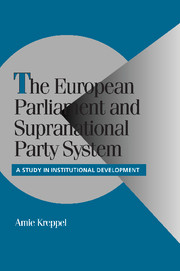Book contents
- Frontmatter
- Contents
- Figures
- Tables
- Acknowledgments
- 1 INTRODUCTION: THE EUROPEAN PARLIAMENT AND THE INSTITUTIONAL EVOLUTION OF LEGISLATURES
- 2 THEORIES OF LEGISLATIVE DEVELOPMENT AND THE EUROPEAN PARLIAMENT
- 3 THE DEVELOPMENT OF THE PARTY GROUP SYSTEM AND THE PARTY GROUPS
- 4 THE HISTORY OF THE EUROPEAN PARLIAMENT
- 5 THE INTERNAL DEVELOPMENT OF THE EUROPEAN PARLIAMENT: FROM COLLEGIALITY TO CONFLICT
- 6 THE DEVELOPMENT OF THE SUPRANATIONAL PARTY GROUP SYSTEM: CONFLICT AND COOPERATION IN THE COALITION FORMATION PROCESS
- 7 COOPERATION AND CO-DECISION: THE ROLE OF IDEOLOGY AND RULES
- 8 THE INTERNAL DEVELOPMENT OF THE SUPRANATIONAL PARTY GROUPS: AN ELUSIVE GOAL
- 9 CONCLUSIONS: UNDERSTANDING THE DEVELOPMENTAL PROCESS
- Appendices
- Bibliography
- Index
- Titles in the series
6 - THE DEVELOPMENT OF THE SUPRANATIONAL PARTY GROUP SYSTEM: CONFLICT AND COOPERATION IN THE COALITION FORMATION PROCESS
Published online by Cambridge University Press: 18 December 2009
- Frontmatter
- Contents
- Figures
- Tables
- Acknowledgments
- 1 INTRODUCTION: THE EUROPEAN PARLIAMENT AND THE INSTITUTIONAL EVOLUTION OF LEGISLATURES
- 2 THEORIES OF LEGISLATIVE DEVELOPMENT AND THE EUROPEAN PARLIAMENT
- 3 THE DEVELOPMENT OF THE PARTY GROUP SYSTEM AND THE PARTY GROUPS
- 4 THE HISTORY OF THE EUROPEAN PARLIAMENT
- 5 THE INTERNAL DEVELOPMENT OF THE EUROPEAN PARLIAMENT: FROM COLLEGIALITY TO CONFLICT
- 6 THE DEVELOPMENT OF THE SUPRANATIONAL PARTY GROUP SYSTEM: CONFLICT AND COOPERATION IN THE COALITION FORMATION PROCESS
- 7 COOPERATION AND CO-DECISION: THE ROLE OF IDEOLOGY AND RULES
- 8 THE INTERNAL DEVELOPMENT OF THE SUPRANATIONAL PARTY GROUPS: AN ELUSIVE GOAL
- 9 CONCLUSIONS: UNDERSTANDING THE DEVELOPMENTAL PROCESS
- Appendices
- Bibliography
- Index
- Titles in the series
Summary
As Chapter 5 demonstrated, the party groups have been fundamental in determining the internal organization of the EP as a whole. Just as the relative power of the groups vis-à-vis individual Members has varied over time, so have their relationships with each other. The purpose of this chapter is to trace the development of the party group system through an examination of the interactions between the party groups in the coalition formation process. This will help to determine the impact of increases in the legislative authority of the European Parliament on the character and evolution of the party system. The analysis will also serve as a test of the usefulness of the macro and micro models in predicting the course of party system, as opposed to parliamentary development.
Past studies of the European Union have generally concluded that the party groups, like the EP itself, are incidental to the functioning of the EU as a whole. The perceived absence of party discipline and leadership (a point that will be discussed further in Chapter 8) combined with their perceived frequent recourse to cooperation across ideological boundaries has led most scholars of the European Union to conclude that the party group system is either nonexistent or unimportant. While the role of the EP has recently begun to be re-appraised in the literature, the significance of the party groups and their interactions have not (Peters, 1992; Nugent, 1994; Corbett et al., 1995).
- Type
- Chapter
- Information
- The European Parliament and Supranational Party SystemA Study in Institutional Development, pp. 123 - 152Publisher: Cambridge University PressPrint publication year: 2001

